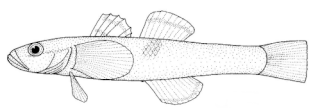
Graham's gudgeon, Grahamichthys radiata, is a species of goby of the family Thalasseleotrididae, the only member of the genus Grahamichthys. This species is found in rock pools and in the neritic zone, to 50 metres (160 ft) in depth, where sand or mud is lies around and partially buries rocks, shells, or other objects. It is unusual for a goby, in that it lives in loose schools. The generic name is a compound formed from the surname Graham in honour of David H. Graham who wrote A Treasury of New Zealand Fishes which was published in 1953 and therefore is an allusion to this taxon being endemic to New Zealand and the Greek ichthys meaning "fish".
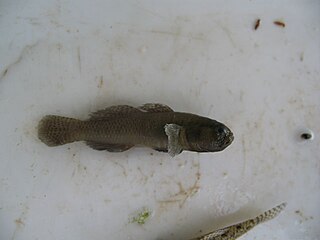
Economidichthys is a genus of freshwater gobies endemic to Greece. The name of this genus honours the Greek ichthyologist Panos Economidis.
Knipowitschia ephesi, the Ephesus goby, is a species of goby endemic to the delta and marshes of the lowermost Küçük Menderes in western Anatolia, Turkey.Turkey where it occurs in stagnant or nearly stagnant fresh waters. Its habitat is threatened by water abstraction, pollution, and destruction and these have an impact on this species, leading to the IUCN to classify it as Critically Endangered. The specific name refers to the ancient, ruined city of Ephesus which was a port located at mouth of the Küçük Menderes.
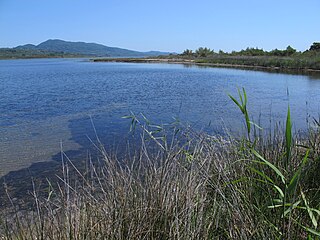
Knipowitschia goerneri, the Corfu dwarf goby, is a species of freshwater goby endemic to the island of Corfu in western Greece. This species can reach a length of 2.2 centimetres (0.87 in) SL. This species was only recorded from a single spring and was considered to have been last recorded in 1983 but surveys in the 1990s failed to find any, it was incorrectly thought that the spring which was the type locality had been affected by water abstraction which may have caused an increase in salinity, but the species had not been recorded at the affected spring. In 2014, nine specimens of Corfu dwarf goby were collected from Korission Lagoon in southern Corfu. The specific name honours Manfred Görner, who supported the author's ichthyological research.
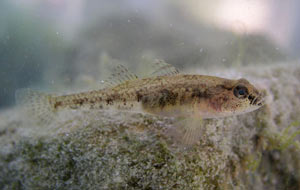
Knipowitschia panizzae, the Adriatic dwarf goby, is a species of goby native to the coasts of the Adriatic and Ionian Seas where it has been recorded in Italy, Slovenia and Croatia with records from Greece needing to be confirmed. It prefers fresh and brackish waters with plentiful vegetation. This species can reach a length of 5.5 centimetres (2.2 in) TL. It is not known who the specific name honours but it is thought likely to be the Italian anatomist Bartolomeo Panizza (1785-1867), who studied the post-reproductive mortality of male sea lampreys.
Knipowitschia cameliae, the Danube delta dwarf goby, is a species of goby known only from the brackish and fresh waters of a lagoon south of the Danube Delta in Romania. This fish is a shallow water species being found in waters less than 1 metre (3.3 ft) deep. This species can reach a length of 3.2 centimetres (1.3 in) SL. This species has been assessed by the IUCN as Critically Endangered, possibly extinct, it was last recorded in 1994 and surveys in that year and 1998 have failed to record the species. The specific name honours Camelia Iliana Nalbant, the wife of the senior author.
Knipowitschia radovici, the Norin goby, is a species of goby endemic to Croatia where it only occurs in the drainage basin of the Neretva River where adults inhabit the deepest parts of the rivers in the strongest current. This species can reach a length of 2.8 centimetres (1.1 in) SL. The specific name honours the Ornithologist Dragan Radović, a friend of the author, Marcelo Kovačić, who encouraged him to sample in the waterbodies of Croatia.
Knipowitschia mrakovcici is a species of freshwater goby Endemic to the Krka River catchment in Croatia where it is only found in lakes. Males of this species can reach a length of 3.2 centimetres (1.3 in) SL while females only reach 2.8 centimetres (1.1 in) SL. The specific name honours the Croatian biologist Milorad Mrakovčić of the University of Zagreb, who provided the author, Peter J. Miller, with the original type material.
Knipowitschia iljini is a species of goby Endemic to the Caspian Sea, where it inhabits the deep waters in the central part. This species can reach a length of 4.7 centimetres (1.9 in) TL. The specific name honours the taxonomist of Gobiiformes Boris Sergeevich Iljin (1889-1958), who researched the gobies of the Black and Caspian seas.

Didogobius is a genus of small marine fish in the family Gobiidae, the true gobies. They are native to the eastern Atlantic Ocean and the Mediterranean Sea. The name of the genus is a compound noun made up of Dido, the mythical founder and first queen of Carthage, and the Latin gobius meaning "goby".
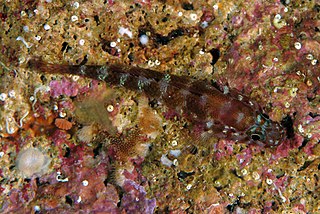
Steinitz's goby is a species of goby. It is native to the Mediterranean Sea near Marseilles. Recently recorded in the Adriatic Sea in Croatia, Tyrrhenian Sea in Italy, and in the Black Sea in Ukraine. This species can be found in underwater grottoes in inshore waters at depths of from 2 to 15 metres. It can reach a length of 3.8 centimetres (1.5 in) SL. The specific name honours the marine biologist and herpetologist Heinz Steinitz (1909-1971) of the Hebrew University, Jerusalem.

Buenia is a genus of gobies native to the eastern Atlantic Ocean and the Mediterranean Sea. The name of the genus and the common name of the type species honour Fernando de Buen y Lozano (1895-1962), the Spanish oceanographer and marine biologist.
Hyrcanogobius bergi, the Volga dwarf goby, is a species of goby endemic to the Caspian Sea where it occurs in fresh, brackish and marine waters along the coast. Unusually for gobies, this species is almost a pelagic fish. This species grows to a length of 3.6 centimetres (1.4 in) SL. This species is the only known member of its genus. The specific name honours the Soviet zoologist Lev Berg (1876-1950) who described many new species of goby from the Caspian Sea.

The largetooth goby, also known as Wilbur's goby, is a species of ray-finned fish from the family Gobiidae which is native to the Indo-Pacific from the Seychelles to Micronesia. Its known range has been extended to the Red Sea as specimens were photographed at one site and collected at another site off Egypt. This species lives in sheltered marine waters at depths of from 0 to 20 metres preferring areas with sandy substrates. This species grows to a length of 6.5 centimetres (2.6 in) SL. This species is the only known member of its genus. This species is not obviously sexually dimorphic and it has a background colour of pale brown to greenish-brown and a pale ventral side. The body is marked with brown and white spots, pairs of larger brown spots create a mid-lateral row along its flanks and there is a dark spot on the caudal fin peduncle. It has a brown blotch on the cheek and a series of short brown bars along its back. The largetooth goby is a solitary fish which is found in coastal bays, lagoons and estuaries over fine sandy substrates close to the margins of reefs or silt beds in the vicinity of sheltered and often turbid coastal reefs. It is most frequently collected from shallow waters to 7 metres (23 ft), around coral reefs but off southern Japan, the largetooth goby occurs at the bottom of sandy bays. The specific name honours the American physician, Ray Lyman Wilbur (1875–1949) who was president of Stanford University from 1916–1943, as well as being the United States Secretary of the Interior from 1929–1933. Wilbur helped the author, Herre, get to Palau, the type locality of this species.
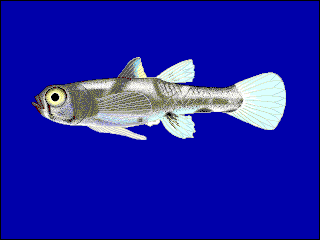
Pandaka is a genus of fish in the goby subfamily, Gobionellinae, native to fresh, brackish and marine waters of Asia and the western Pacific Ocean. Some species in the genus are among the smallest fish in the world; the male P. pygmaea can be just 9 mm (0.35 in) in standard length at maturity.
Ferrer's goby is a species of goby native to the Mediterranean Sea where it occurs in inshore waters inhabiting areas with sandy substrates. This species grows to a length of 3.5 centimetres (1.4 in) TL. This species is the only known member of its genus. The specific name honours Jaume Ferrer Aledo (1854-1956), a pharmacist and amateur ichthyologist who studied the fish fauna in the Balearic Islands.
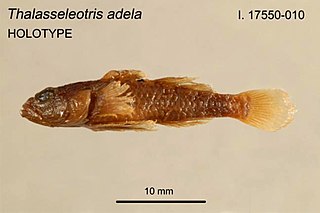
Thalasseleotris is a genus of gobies comprising two species in the family Thalasseleotrididae from the south-western Pacific Ocean in the seas off Australia and New Zealand. The generic name is derived from the Greek Thalassa meaning "sea" and the generic name Eleotris as at the time it was named the genus was considered to be in the family Eleotridae.
Knipowitschia byblisia, the Byblis goby, is a species of ray-finned fish from the family Gobiidae which is endemic to a single lake in western Anatolia. This species is endemic to Lake Köycegiz, a brackish lake in eastern Anatolia near the Aegean Sea. The lake is a protected and the species is abundant within the lake so the IUCN have classified K. byblis as Least Concern. The specific name references the mythological figure Byblis, who was the twin sister of Caunos, the legendary founder of the ancient city Kaunos, the ruins of which are situated on the southwest Anatolian coast; near to Lake Köycegiz.
Knipowitschia caunosi, the Caunos goby or Köycegiz dwarf goby, is a species of ray-finned fish from the family Gobiidae which is endemic to a single lake in western Anatolia. This species is endemic to Lake Köycegiz, a brackish lake in eastern Anatolia near the Aegean Sea. The lake is a protected and the species is abundant within the lake so the IUCN have classified K. caunosi as Least Concern. The specific name references the mythological figure Caunos, who was the twin sister of Byblis, in legend his sister fell in love with him and he fled to avoid committing incest, founding the ancient city Kaunos in Caria, the ruins of which are situated on the southwest Anatolian coast; near to Lake Köycegiz.
Helen K. Larson is an ichthyologist who specialises in the fishes of the Indo-Pacific.










